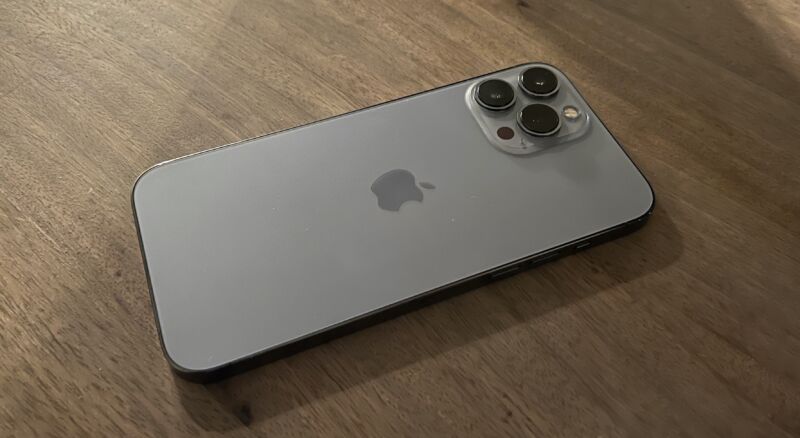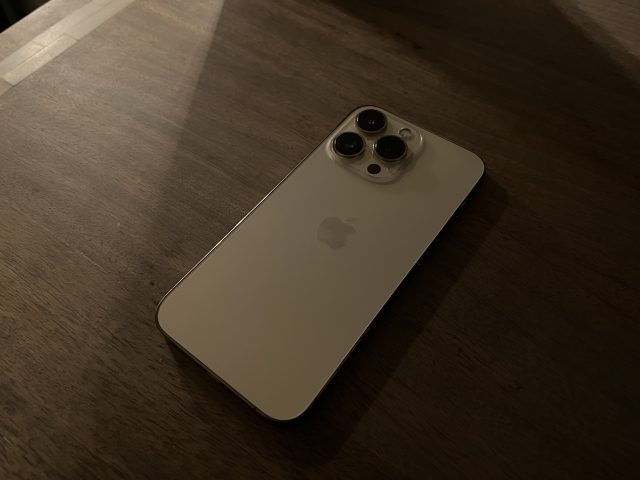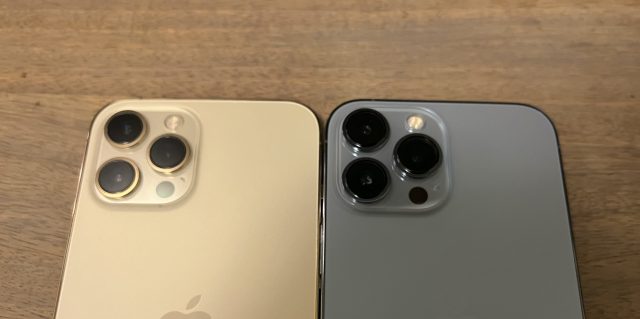

iPhone 13 and 13 Pro review: If you could have three wishes
source link: https://arstechnica.com/gadgets/2021/09/iphone-13-and-13-pro-review-if-you-could-have-three-wishes/
Go to the source link to view the article. You can view the picture content, updated content and better typesetting reading experience. If the link is broken, please click the button below to view the snapshot at that time.

Technology Genie —
iPhone 13 and 13 Pro review: If you could have three wishes
The new iPhone offers better battery life, superior cameras, and great screens.
Samuel Axon - 9/24/2021, 2:01 PM

Imagine you were visited by a genie who would grant you three wishes, but they all had to be about what you want from your next smartphone. As market research and surveys tell it, almost everyone would make the same three wishes: great battery life, excellent cameras, and big, beautiful screens.
This year, Apple is that technology genie, because that’s exactly what the iPhone 13, iPhone 13 mini, iPhone 13 Pro, and iPhone 13 Pro Max deliver when they hit store shelves today.
Cupertino’s flagship phone lineup might seem like an iterative “S”-style update, given that the phones look almost the same as last year's models and that there are no major new features apart from screens with higher refresh rates in the priciest models. But since Apple zeroed in on most people's highest priorities, this seemingly iterative update ends up being a noteworthy one.
Specifications
Specs at a glance: iPhone 13, 13 mini, 13 Pro, 13 Pro Max Screen 2532×1170 6.1-inch OLED (13/Pro), 2778x1284 6.7-inch OLED (13 Pro Max), 2340x1080 5.4-inch OLED (13 mini) OS iOS 15 CPU Apple A15 Bionic RAM 4GB (13/mini); 6GB (13 Pro/Max) GPU Apple A15 Bionic Storage 128, 256, or 512GB for 13/mini; 128, 256, 512GB, or 1TB for 13 Pro/Max Networking Wi-Fi 6, Bluetooth 5, 5G Ports Lightning Camera Two 12MP rear cameras (wide-angle, ultra-wide-angle) for 13/mini; three 12MP rear cameras (wide-angle, ultra-wide-angle, telephoto) for 13 Pro/Max; 7MP front camera; Dolby Vision HDR 4K video capture Size 146.7×71.5×7.65mm (13/13 Pro), 160.8×78.1×7.65mm (Max), 131.5×64.2×7.65mm (mini) Weight 173 g (13), 204 g (Pro), 240 g (Max), 140 g (mini) Starting price $699 (mini), $799 (13), $999 (Pro), $1,099 (Max) Other perks MagSafe, Face IDLast year, I stopped short of recommending the iPhone 12 Pro because the iPhone 12 offered enough. The two phones were not significantly differentiated beyond nicer materials and the inclusion of a zoom lens and a lidar sensor in the pricier phone. This time around, the Pro model has some more going for it: a better camera system, faster graphics, and markedly improved battery life over the iPhone 13.
Now it’s the iPhone 13 Pro and iPhone 13 Pro Max that aren’t all that different from each other. For reference, last year saw the Max get the better camera system. Now they're the same, so it's just about screen size and battery life.
Battery life
Apple claims that the iPhone 13 mini can last for 13 hours when playing a streaming video, and the iPhone 13 is rated for 15 hours. It’s a big leap up to the iPhone 13 Pro, which claims to offer 20 hours—and the iPhone 13 Pro Max promises a remarkable 25 hours.
This is thanks to several things, like a more efficient processor, the ProMotion display in the Pro phones (we’ll get to that soon), and importantly, bigger batteries. Apple has rejiggered the internals in all the phones to make room for more battery capacity. When it comes to lithium-ion batteries, you can’t change the laws of physics—but you can brute force them.
A15 Bionic
That more efficient processor is the A15. Apple hasn’t made many specific performance claims about how the A15 compares to last year’s A14, but we know the new SoC has a 6-core CPU with two performance and four efficiency cores, a 5-core (in the Pro models) or 4-core (in the regular iPhone 13 models) GPU, and a 16-core NPU (that's "neural processing unit," for hardware-accelerated machine learning).
AdvertisementPerformance doesn’t seem to be the main focus of Apple’s latest iPhone refresh—which is just fine, because last year’s phones were already far and away the fastest on the market, and no one else has matched them. But we’ll share our benchmark results later in the review.
Dimensions
The iPhone 13 measures 5.78×2.82×0.3 inches, or 146.7×71.5×7.65 millimeters. The iPhone 13 mini comes in at 5.18×2.53×0.3 inches, or 131.5×64.2×7.65 millimeters.
That makes them ever so slightly thicker than their predecessors. The iPhone 13 mini is still adorably tiny, and it’s great to see a one-handed phone with so many features in Apple’s lineup again. If only we could be confident it will still be around next year.
Both weigh more than their 2020 counterparts, at 6.1 ounces or 173 grams for the iPhone 13, and 4.94 ounces or 140 grams for the iPhone 13 mini. That’s up from 5.78 ounces/164 grams and 4.76 ounces/135 grams, respectively.
Meanwhile, the iPhone 13 Pro is 7.19 ounces or 204 grams, and the iPhone 13 Max is a hefty 8.46 ounces or 240 grams. Last year: 6.6 ounces/189 grams for the 13 Pro and 7.96 ounces/226 grams for the Max. You’d feel the difference when holding them side by side with the iPhone 12 Pro and iPhone 12 Pro Max.
The iPhone 13 Pro is 5.78×2.82×0.3 inches, or 146.7×71.5×7.65 millimeters. The iPhone 13 Pro Max: 6.33×3.07×0.3 inches, or 160.8×78.1×7.65 millimeters. They’re also a smidge thicker than last year’s comparable devices.

Storage
For the first time, the Pro models can be configured with 1TB of storage at purchase. To be honest, I don't think most people need that much storage on their phones. I have more than 200 apps and games installed on mine—far more than your average iPhone user—and some 4K videos to boot, and I nudge right up to the 256GB mark. I have a long way to go before 512GB might become inadequate.
You could hit that 1TB mark relatively easily if you’re shooting a lot of ProRes video (once that capability is added), but that’s not going to be a common use case.
More exciting is the fact that the lower-priced iPhone 13 and iPhone 13 mini now start at 128GB instead of a paltry 64GB but for the same price that the 64GB models cost last year. Further, they can now be configured with up to 512GB of storage, which is plenty for almost everyone.
AdvertisementAll told, the iPhone 13 and iPhone 13 mini come in 128GB, 256GB, and 512GB configurations, and the iPhone 13 Pro and Pro Max offer all the same, plus the 1TB option.
Design
Apple has again differentiated the iPhone 13 Pro and iPhone 13 Pro Max from their slightly lower-end siblings via the materials; the former have stainless-steel edges with a beautiful treatment on them, plus rougher backs that feel nice to hold. The iPhone 13 and iPhone 13 mini have aluminum edges and plainer backs, but they still feel great.
Last year, I described the iPhone 12 and iPhone 12 Pro’s design as a throwback to the iPhone 4 and iPhone 5, which many people (myself included) consider to be the nicest-looking iPhones. That same design returns today. It’s the exact same look and feel as before, with two notable exceptions.
Nicer notch
The most-discussed design change addresses something that never bothered me too much but that sure seemed to drive a lot of other folks batty: the notch, that opaque black segment on the phone’s screen that houses the front-facing sensor array.For the first time since the notch was introduced, it has become smaller—by about 20 percent horizontally. It’s slightly taller (you wouldn’t know that part without looking at it side by side with a previous iPhone) but overall, you’re getting some screen real estate back.

This mainly matters for some full-screen games or other apps with custom interfaces, whose designers just chose to pretend like the notch wasn’t there when laying out the UI. Apple hasn’t made any changes to its own software to make use of this reclaimed space.
Colossal cameras
But the slightly shrunken notch is not the most noticeable design change compared to the iPhone 12 and iPhone 12 Pro. The rear camera system is huge. The lenses are bigger. The camera bump protrudes farther. It’s impossible not to notice.
It doesn’t look any better or worse than last year’s camera bump. But something else about this change really bugs me: it makes the phone wobble wildly when placed flat on a table or desk.
I know, I know—the past several iPhones already did that to some degree. It bothered me a little then, too, but this is another level. It sometimes makes it awkward to type on or otherwise use the phone in that position. This applies to both the iPhone 13 and the iPhone 13 Pro, but it’s worse with the iPhone 13 Pro.

That said, cameras are key, and this is how we get better cameras, I suppose.
As with other recent phones, the Apple-made cases for the iPhone 13 and iPhone 13 Pro make the back flush again, suggesting that Apple would probably prefer a design like that too. Nonetheless, I’m sure Apple is happy to upsell you on those cases to get your phone nice and flush!
Page:
Recommend
About Joyk
Aggregate valuable and interesting links.
Joyk means Joy of geeK